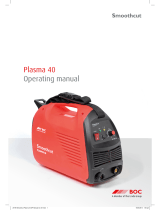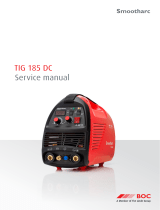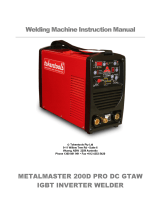Page is loading ...

MMA 140 /160
OPERATING MANUAL

2
Welcome to a better way of welding
Congratulations on puchasing the MagMate™ MMA 140 /160
welding machine.
The products in BOC's manual metal arc range perform with reliability and have
the backing of one of South Pacifi c's leading welding suppliers.
This operating manual provides the basic knowledge required for MMA welding,
as well as highlighting important areas of how to operate the MagMate MMA
140 /160 welding machine.
With normal use, and by following these recommended steps, your MagMate
MMA 140 /160 machine can provide you with years of trouble free service.
BOC equipment and technical support is available through our national BOC
Customer Service Centre or contact your local Gas & Gear outlet.
Important Notice: This document has been prepared by BOC Limited ABN 95 000 029 729 ('BOC'),
as general information and does not contain and is not to be taken as containing any specifi c instructions.
The document has been prepared in good faith and is professional opinion only. Information in this document
has been derived from third parties, and though BOC believes it to be reliable as at the time of printing, BOC
makes no representation or warranty as to the accuracy, reliability or completeness of information in this
document and does not assume any responsibility for updating any information or correcting any error or
omission which may become apparent after the document has been issued. Neither BOC nor any of its agents
has independently verifi ed the accuracy of the information contained in this document. The information in this
document is commercial in confi dence and is not to be reproduced. The recipient acknowledges and agrees
that it must make its own independent investigation and should consider seeking appropriate professional
recommendation in reviewing and evaluating the information. This document does not take into account the
particular circumstances of the recipient and the recipient should not rely on this document in making any
decisions, including but not limited to business, safety or other operations decisions.
Except insofar as liability under any statute cannot be excluded, BOC and its affi liates, directors, employees,
contractors and consultants do not accept any liability (whether arising in contract, tort or otherwise) for any
error or omission in this document or for any resulting loss or damage (whether direct, indirect, consequential
or otherwise) suffered by the recipient of this document or any other person relying on the information
contained herein. The recipient agrees that it shall not seek to sue or hold BOC or their respective agents liable
in any such respect for the provision of this document or any other information.

3
Welcome to a better way of welding 2
1.0 Recommended Safety Guidelines 4
2.0 Recommended Safety Precautions 5
2.1 Health Hazard Information 5
2.2 Personal Protection 5
2.3 Electrical Shock 6
2.4 User Responsibility 6
3.0 Basic Welding Techniques 7
3.1 Fundamentals of Manual Metal Arc (MMA)
Welding 7
4.0 Machine Specifi cations and Contents 9
4.1 Operating Controls 9
4.2 Package Contents 9
5.0 Operating Functions 10
5.1 Operating Machine 10
5.2 Earthing 10
6.0 Technical Specifi cations 11
7.0 Periodic Maintenance 12
7.1 Daily Maintenance 12
7.2 Troubleshooting 12
8.0 Terms of Warranty 13
8.1 Terms of Warranty 13
8.2 Limitations on Warranty 13
Contents

4
• Repair or replace defective cables immediately.
• Never watch the arc except through
lenses of the correct shade.
• In confi ned spaces, adequate ventilation
and constant observation are essential.
• Leads and cables should be kept clear
of passageways.
• Keep fi re extinguishing equipment at a handy
location in the shop.
• Keep primary terminals and live parts
effectively covered.
• Never strike an electrode on any gas cylinder.
• Never use oxygen for venting containers.
1.0 Recommended Safety Guidelines
Diagram and safety explanation
Electrical safety alert
Welding electrode causing
electric shock
Fumes and gases coming from
welding process
Welding arc rays
Read instruction manual
Become trained
Diagram and safety explanation
Wear dry, insulated gloves
Insulate yourself from
work and ground
Disconnect input power before
working on equipment
Keep head out of fumes
Use forced ventilation or local
exhaust to remove fumes
Use welding helmet with
correct shade of fi lter
Some safety precautions BOC recommends are as follows:

5
2.1 Health Hazard Information
The actual process of welding is one that
can cause a variety of hazards.
All appropriate safety equipment should be
worn at all times, i.e. headwear, respiratory,
hand and body protection. Electrical equipment
should be used in accordance with the
manufacturer’s recommendations.
Eyes:
The process produces ultra violet rays that
can injure and cause permanent damage.
Fumes can cause irritation.
Skin:
Arc rays are dangerous to uncovered skin.
Inhalation:
Welding fumes and gases are dangerous to
the health of the operator and to those in
close proximity. The aggravation of pre-existing
respiratory or allergic conditions may occur in
some workers. Excessive exposure may cause
conditions such as nausea, dizziness, dryness
and irritation of eyes, nose and throat.
2.2 Personal Protection
Respiratory
Confi ned space welding should be carried out
with the aid of a fume respirator or air supplied
respirator as per AS/NZS 1715 and AS/NZS
1716 Standards.
• You must always have enough ventilation in
confi ned spaces. Be alert to this at all times.
• Keep your head out of the fumes rising from
the arc.
• Fumes from the welding of some metals could
have an adverse effect on your health. Don’t
breathe them in. If you are welding on material
such as stainless steel, nickel, nickel alloys
or galvanised steel, further precautions are
necessary.
• Wear a respirator when natural or forced
ventilation is not good enough.
Eye protection
A welding helmet with the appropriate welding
fi lter lens for the operation must be worn at all
times in the work environment. The welding arc
and the refl ecting arc fl ash gives out ultraviolet
and infrared rays. Protective welding screen and
goggles should be provided for others working
in the same area.
Clothing
Suitable clothing must be worn to prevent
excessive exposure to UV radiation and
sparks. An adjustable helmet, fl ameproof loose
fi tting cotton clothing buttoned to the neck,
protective leather gloves, spats, apron and steel
capped safety boots are highly recommended.
Recommended fi lter shades for
arc welding
Less than 150 amps Shade 10*
150 to 250 amps Shade 11*
250 to 300 amps Shade 12
300 to 350 amps Shade 13
Over 350 amps Shade 14
*Use one shade darker for aluminium
2.0 Recommended Safety Precautions

6
2.3 Electrical Shock
• Never touch ‘live’ electrical parts.
• Always repair or replace worn or
damaged parts.
• Disconnect power source before
performing any maintenance or service.
• Earth all work materials.
• Never work in moist or damp areas.
Avoid electric shock by:
• Wearing dry insulated boots
• Wearing dry leather gloves
• Never changing electrodes with bare
hands or wet gloves
• Never cooling electrode holders in water
• Working on a dry insulated fl oor where
possible
• Never hold the electrode and holder
under your arm.
2.4 User Responsibility
• Read the Operating Manual prior to
installation of this machine.
• Unauthorised repairs to this equipment may
endanger the technician and operator and will
void your warranty. Only qualifi ed personnel
approved by BOC should perform repairs.
• Always disconnect mains power before
investigating equipment malfunctions.
• Parts that are broken, damaged, missing or
worn should be replaced immediately.
• Equipment should be cleaned periodically.
BOC stocks a huge range of personal protective
equipment. This, combined with BOC’s
extensive Gas and Gear network, ensures fast,
reliable service throughout the South Pacifi c.
PLEASE NOTE that under no circumstances
should any equipment or parts be altered
or changed in any way from the standard
specifi cation without written permission
given by BOC. To do so, will void the
Equipment Warranty.
Further information can be obtained
from Welding Institute of Australia
(WTIA) Technical Note No.7
‘Health and Safety Welding’
Published by WTIA,
PO Box 6165 Silverwater NSW 2128
Phone (02) 9748 4443.

7
3.1 Fundamentals of Manual
Metal Arc (MMA) Welding
Welding Technique
Successful MMA welding depends on the
following factors:
Selection of the correct electrode.
Selection of the correct size of the electrode
for the job.
Correct welding current.
Correct arc length.
Correct angle of electrode to work.
Correct travel speed.
Correct preparation of work to be welded.
Electrode selection
As a general rule, the selection of an electrode
is straight forward, in that it is only a matter of
selecting an electrode of similar composition
to the parent metal. However, for some metals
there is a choice of several electrodes, each
of which has particular properties to suit
specifi c classes of work. Often, one electrode
in the group will be more suitable for general
applications due to its all round qualities.
Electrode size
The size of the electrode generally depends on
the thickness of the section being welded, and
the thicker the section the larger the electrode
required. In the case of light sheet, the electrode
size used is generally slightly larger than the
work being welded. This means that, if 2.0 mm
sheet is being welded, 2.5 mm diameter
electrode is the recommended size.
Welding current
Correct current selection for a particular job
is an important factor in arc welding. With the
current set too low, diffi culty is experienced
in striking and maintaining a stable arc.
The electrode tends to stick to the work,
penetration is poor and beads with a distinct
rounded profi le will be deposited.
Excessive current is accompanied by
overheating of the electrode. It will cause
undercut and burning through of the material,
and will give excessive spatter. Normal current
for a particular job may be considered as the
maximum, which can be used without burning
through the work, over-heating the electrode
or producing a rough spattered surface (i.e. the
current in the middle of the range specifi ed
on the electrode package is considered to be
the optimum).
Arc length
To strike the arc, the electrode should be gently
scraped on the work until the arc is established.
There is a simple rule for the proper arc length;
it should be the shortest arc that gives a good
surface to the weld. An arc too long reduces
penetration, produces spatter and gives a rough
surface fi nish to the weld. An excessively
short arc will cause sticking of the electrode
and rough deposits that are associated with
slag inclusions.
For down hand welding an arc length not
greater than the diameter of the core wire will
be most satisfactory. Overhead welding requires
a very short arc so that a minimum of metal will
be lost.
Electrode angle
The angle that the electrode makes with the
work is important to ensure a smooth, even
transfer of metal.
Correct travel speed
The electrode should be moved along in the
direction of the joint being welded at a speed
that will give the size of run required. At the
3.0 Basic Welding Techniques

8
same time, the electrode is fed downwards to
keep the correct arc length at all times.
Correct travel speed for normal welding
applications varies between approximately
100 and 300 mm per minute, depending on
electrode size, size of run required and the
amperage used. Excessive travel speeds lead to
poor fusion, lack of penetration etc, while too
slow a rate of travel will frequently lead to arc
instability, slag inclusions and poor mechanical
properties.
Correct work preparation
The method of preparation of components to
be welded will depend on equipment available
and relative costs. Methods may include sawing,
punching, shearing, machining, fl ame cutting
and others.
In all cases edges should be prepared for the
joints that suit the application.
Generally Recommended Current Range
for MMA electrodes
Size of Electrode (mm) Current Range (Amp)
2.5 60–95
3.2 110–130
4.0 140–165
5.0 170–260

9
1Overtemperature control indicator
2On/Off switch (behind machine)
3Power indicator light
4Welding current adjustment
5Negative '35' dinse connector
6Positive '35' dinse connector
4.0 Machine Specifi cations and Contents
4.1 Operating Controls
1
2
6
43
5
4.2 MMA 140 Package Contents
• MMA 140 Power source
• Electrode holder with cable (dinse connector)
• Work clamp with cable (dinse connector)
• Primary cable with plug (10 amp)
• Operating manual
4.3 MMA 160 Package Contents
• MMA 160 Power source
• Electrode holder with cable (dinse connector)
• Work clamp with cable (dinse connector)
• Primary cable with plug (15 amp)
• Operating manual

10
1
43
1Overtemperature control indicator
2On/Off switch (behind machine)
3Power indicator light
4Welding current adjustment
For MMA welding
Connect the electrode holder to the positive
(+) output terminal 6 and the work return
lead should be connected to the negative (-)
output terminal 5.
The welding current can be adjusted with the
welding current adjustment knob 4.
The machine will stop working if the temperature
reaches a certain level. (Exceeds the unit's duty
cycle). The overtemperature control indicator
light 1 will illuminate.
NOTE:
When changing the MMA electrode holder the machine should be
switched off using the power switch on the machine. In addition,
the main supply must be turned off and the plug removed from
the outlet socket.
5.1 Operating Machine
■Select the current as per the
recommendations of the consumable
manufacturer.
■Select the polarity of the electrode cable as
per the recommendations (+/-)
5.2 Earthing
For the welding process to be most effective
it is important to ensure that there is a solid
connection between the work return clamp and
the workpiece.
Always ensure that the return clamp is as close as
practically possible to the area to be welded.
Ensure that the workpiece is clean and free from
rust, scale paint or oil and grease before affi xing
the work return clamp.
5.0 Operating Functions

11
6.0 Technical Specifi cations
MagMate™ MMA 140 MagMate™ MMA 160
Part No. MAGMMA140DIY MAGMMA160DIY
Power voltage (V) Single phase AC 230V ± 15% Single phase AC 230V ± 15%
Frequency (Hz) 50 / 60 50 / 60
Rated input plug (A) 10A 15A
Output current adjustment (A) 15-140 15-160
Output voltage (V) 20.6-25.6 20.6-26.4
No-load voltage (V) 18 18
Duty cycle (%) 20 @ 120A 20 @ 160A
Power factor 0.73 0.73
Effi ciency (%) 85 85
Insulation grade F F
Housing protection grade IP21 IP21
Weight (kg) 4.5 4.5
Overall dimensions (mm) 292 x 136 x 235 292 x 136 x 235
KVa 6 6
Standards IEC 60974.1 IEC 60974.1

12
In maintenance of the unit, take into
consideration the rate of use and the
environment it is used in. When the unit is used
properly and serviced regularly you will avoid
unnecessary disturbances in use and production.
7.1 Daily Maintenance
Perform the following maintenance daily:
• Clean electrode holder. Replace damaged or
worn parts.
• Check tightness of welding and earth cable
connections.
• Check condition of mains and welding cables.
• See that there is enough space in front of and
back of the unit for ventilation.
7.2 Troubleshooting
Main switch signal light is not lit.
Unit does not get electricity.
• Check mains fuses.
• Check mains cable and plug.
Unit does not weld well.
Arc is uneven and goes off. Electrode gets stuck
in weld pool.
• Check welding settings and adjust when
necessary.
• Check that the work return clamp is properly
fi xed and that contact surface is clean and the
cable is undamaged.
Signal light for overheating is lit.
The unit has overheated. See 5.0 Operating
Functions.
• Check that there is ample space in front of
and back of the unit for ventilation.
• Check welding settings. See 5.0 Operating
Functions.
If problems in use are not solved with above
mentioned measures, please contact your local
BOC representative.
7.0 Periodic Maintenance

13
Warranty for MagMate™
MMA 140 /160
8.1 Terms of Warranty
BOC provides a warranty for the MagMate
MMA 140 /160 sold by it against defects in
manufacture and materials.
Machines under warranty will be
exchanged and not repaired.
• Valid for 18 months from date of purchase.
• Freight, packaging and insurance costs are to
be paid for by the claimant.
• No additional express warranty is given unless in
writing signed by an authorised manager of BOC.
• This warranty is in addition to any other legal
rights you may have.
• Electrode holders and torches are not
covered.
8.2 Limitations on Warranty
The following conditions are not covered:
• Non compliance with operating and
maintenance instructions such as connection
to incorrect faulty voltage supply including
voltage surges outside equipment specs and
incorrect overloading.
• Natural wear and tear and accidental damage.
• Transport or storage damage.
The Warranty is void if:
• Changes are made to the product without the
approval of the manufacturer.
• Repairs are carried out.
8.0 Terms of Warranty

14

15

16
MagMate™ is distributed by:
BOC Limited
ABN 95 000 029 729
10 Julius Avenue
North Ryde, NSW 2113
AUSTRALIA
BOC is a trading name of BOC Limited, a member of The Linde Group, © BOC Limited 2014. Reproduction without permission is strictly
prohibited. Details given in this document are believed to be correct at the time of printing. Whilst proper care has been taken in the
preparation, no liability for injury or damage resulting from its improper use can be accepted.
BOC Limited
970 – 988 Great South Road
Penrose, Auckland
NEW ZEALAND
For more information on MagMate products or service,
call the BOC Customer Service Centre on:
AUSTRALIA
131 262
www.boc.com.au
NEW ZEALAND
0800 111 333
www.boc.co.nz
MP14-0145 . FDAUS . 0714
/





